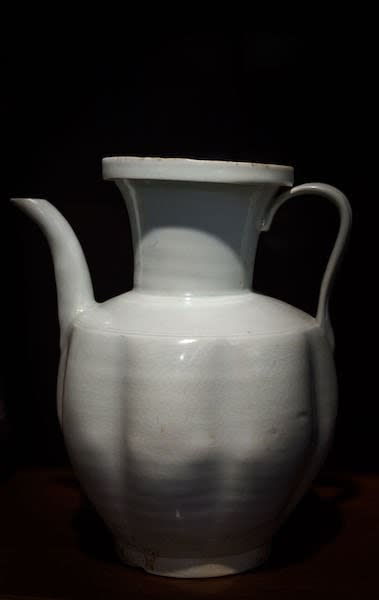Song Dynasty porcelain ewer, 960 BCE - 1279 BCE
Porcelain
RL.0967
In terms of technical expertise, inventiveness, and aesthetic perfection of glaze and shape, Song period ceramics stand unrivaled for th quality of its ware, constituting a magnificent expression of ceramic...
In terms of technical expertise,
inventiveness, and aesthetic perfection of glaze and shape, Song period ceramics stand unrivaled for th quality of its ware, constituting a magnificent expression of ceramic art, not only in China but in the entire world.
During the Song period, a unity of the essential components which are fundamental to the ceramist's art, such as vessel shape, potting techniques, glaze, decoration, firing processes, and aesthetic theory were all masterfully combined in a high standard of excellence. In general, the shapes used during the Song Dynasty are rather simple and sedate by comparison to what preceded them and what was to follow. Likewise, the glazes tend to be monochromatic and subtle, a fluid, integral part of the form of the vessel, they cover, with a depth of color and texture that invites the spectator to both touch and contemplate. Song aesthetic sophistication was matched by an incredible inventiveness, which led to a variety of classic wares, usually associated with a specific region of China. These included the court-patronized five famous kilns: Ru, Guan, Ge, Jun and Ding wares, as well as the Longquan celadons.
Several of these regional ceramic wares were so valued during their day that they were used as tribute and yearly taxes to the imperial court.
inventiveness, and aesthetic perfection of glaze and shape, Song period ceramics stand unrivaled for th quality of its ware, constituting a magnificent expression of ceramic art, not only in China but in the entire world.
During the Song period, a unity of the essential components which are fundamental to the ceramist's art, such as vessel shape, potting techniques, glaze, decoration, firing processes, and aesthetic theory were all masterfully combined in a high standard of excellence. In general, the shapes used during the Song Dynasty are rather simple and sedate by comparison to what preceded them and what was to follow. Likewise, the glazes tend to be monochromatic and subtle, a fluid, integral part of the form of the vessel, they cover, with a depth of color and texture that invites the spectator to both touch and contemplate. Song aesthetic sophistication was matched by an incredible inventiveness, which led to a variety of classic wares, usually associated with a specific region of China. These included the court-patronized five famous kilns: Ru, Guan, Ge, Jun and Ding wares, as well as the Longquan celadons.
Several of these regional ceramic wares were so valued during their day that they were used as tribute and yearly taxes to the imperial court.
